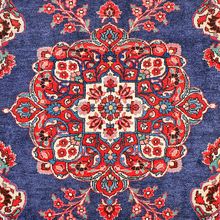Semnan Rug
| Semnan Rug | |
|---|---|
 Design of Semnan Rug (Rugman) | |
| General information | |
| Name | Semnan Rug |
| Original name | قالی سمنان |
| Alternative name(s) | Semnan Carpet |
| Origin | |
| Category | City |
| Technical information | |
| Common designs | Vagireh, Afshan, Geometric |
| Common colors | Red, Blue, Yellow, Green, Ivory |
| Dyeing method | Natural, Synthetic |
| Pile material | Wool |
| Foundation material | Cotton |
| Knot type | Asyemmetrical (Persian), Symmetrical (Turkish) |
Semnan rugs originate from Semnan, located on a large plain along the southern edge of the Alborz Mountains between Tehran and Mashad. Known for its superbly crafted area rugs, Semnan is also a thriving marketplace for local grains, cotton, and tobacco. Although Semnan can now boast over 50,000 inhabitants, production of area rugs is rather limited, creating a very high demand, particularly among collectors. All Semnan rugs are very finely and densely woven with thick wool strands by extremely skilled artisans using the Persian asymmetrical knot.
History
Semnan is the capital city of the Semnan Province in northeastern Iran. Until recently, it was located within the Khorasan Province. It is an old city, situated on the road between Meshad and Tehran, and is an important trade center for the surrounding towns and villages. Semnan rugs and carpets are known in the market from the late nineteenth century. The weavings have a cotton foundation and a wool pile. The Persian (asymmetric) knot is employed.
Semnan carpets are floral in design, with red-blue background coloration greatly similar to Meshad carpet styles. The nineteenth-century rugs were limited in production and were woven mainly for domestic use. Some examples of extremely fine rugs made during this period are in collectors' hands today. Twentieth-century Semnan weavings are attributed to Meshad or Khorasan in origin in the Western markets.
The rug designs have a medallion or allover style with traditional Shah Abbas palmette, leaf, and vine motifs delicately woven in the background and borders. At times, the medallions are large, circular, and placed in the center of the field.
The fields and borders display reds or blues. In addition to these colors, different shades of green, gold, gray, ivory, cinnamon, brown, or other traditional hues were used for the design elements.
Semnan rug dimensions vary from approximately five feet by three feet to room sizes. The weavings are recognized for their durability and tight weave.
By the late twentieth century, some Semnan weavers switched from using traditional designs to making rugs similar to those of other weaving regions in Iran in order to meet the demand of domestic and foreign export consumers.[1]
See also
| Search for Semnan Rug on Wikipedia. |
References
- ↑ Moheban, 2015, 509-510
Bibliography
- Abraham Levi Moheban. 2015. The Encyclopedia of Antique Carpets: Twenty-Five Centuries of Weaving. NewYork: Princeton Architectural Press.